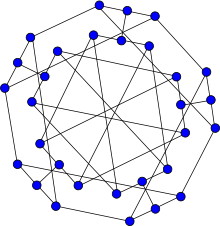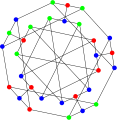- Double-star snark
-
Double-star snark 
The Double-star snarkVertices 30 Edges 45 Chromatic number 3 Chromatic index 4 Properties Snark
Hypohamiltonianv · mathematical field of graph theory, the double-star snark is a snark with 30 vertices and 45 edges.[1] In 1975, Rufus Isaacs introduced two infinite families of snarks—the flower snark and the BDS snark, a family that includes the two Blanuša snarks, the Descartes snark and the Szekeres snark (BDS stands for Blanuša Descartes Szekeres).[2] Isaacs also discovered one 30-vertex snark that does not belongs to the BSD family and that is not a flower snark — the double-star snark.
As a snark, the double-star graph is a connected, bridgeless cubic graph with chromatic index equal to 4. The double-star snark is non-planar and non-hamiltonian but is hypohamiltonian.[3]
Gallery
References
- ^ Weisstein, Eric W., "Double Star Snark" from MathWorld.
- ^ Isaacs, R. (1975), "Infinite families of non-trivial trivalent graphs which are not Tait-colorable", American Mathematical Monthly (Mathematical Association of America) 82 (3): 221–239, doi:10.2307/2319844, JSTOR 2319844
- ^ Weisstein, Eric W., "Hypohamiltonian Graph" from MathWorld.

This combinatorics-related article is a stub. You can help Wikipedia by expanding it.v · Categories: - Individual graphs
- Regular graphs
- Combinatorics stubs
Wikimedia Foundation. 2010.
Look at other dictionaries:
Snark double étoile — Représentation du snark double étoile Nombre de sommets 30 Nombre d arêtes 45 Distribution des degrés 3 régulier Rayon … Wikipédia en Français
Snark (graph theory) — In graph theory, a snark is a connected, bridgeless cubic graph with chromatic index equal to 4. In other words, it is a graph in which every vertex has three neighbors, and the edges cannot be colored by three colors without two edges of the… … Wikipedia
Cubic graph — Not to be confused with graphs of cubic functions. The Petersen graph is a Cubic graph … Wikipedia
8 (number) — Evolution of the glyphIn the beginning, various groups in India wrote eight more or less in one stroke as a curve that looks like an uppercase H with the bottom half of the left line and the upper half of the right line removed. At one point this … Wikipedia
Doorways in the Sand — … Wikipedia
rocket and missile system — ▪ weapons system Introduction any of a variety of weapons systems that deliver explosive warheads to their targets by means of rocket propulsion. Rocket is a general term used broadly to describe a variety of jet propelled missiles… … Universalium
Prix Locus du meilleur roman court — Les prix Locus sont décernés chaque année, depuis 1971, par les lecteurs du magazine américain mensuel de science fiction Locus lors de la Westercons qui se déroule le quatrième week end de juillet. La catégorie du meilleur roman court (novella)… … Wikipédia en Français
Alien (film) — Alien … Wikipedia
The End of Time — This article is about the Doctor Who television special. For other uses, see The End of Time (disambiguation). 202 – The End of Time Doctor Who serial The return of the Time Lords … Wikipedia
Alice Au Pays Des Merveilles — Pour les articles homonymes, voir Alice au pays des merveilles (homonymie). Alice au pays des merveilles … Wikipédia en Français
18+© Academic, 2000-2025- Contact us: Technical Support, Advertising
Dictionaries export, created on PHP, Joomla, Drupal, WordPress, MODx.Share the article and excerpts
Double-star snark
- Double-star snark
-
Double-star snark 
The Double-star snarkVertices 30 Edges 45 Chromatic number 3 Chromatic index 4 Properties Snark
Hypohamiltonian


